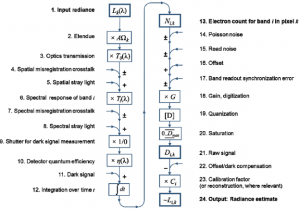P4001 is comprised of three Working Groups, each with its own mission:
Terminology – WG-T1
There are many documents that provide an explanation of terms germane to Hyperspectral Technology, however, there is no specific reference or glossary that one can easily access to find comprehensive and quantitative definitions. A fundamental underpinning of establishing methods and means for testing, and for accurately and unambiguously conveying product specifications, is having written definitions and well defined equations (where possible) that objectively and unambiguously define these terms. The focus of this working group is collect, organize and define terms as related to the testing and characterization of Hyperspectral instruments.
Characterization – WG-C1
Testing and characterization of Hyperspectral instruments is currently in an amorphous state and needs clear definition of basis tests and quantitative values. These values and tests should be stated clearly by manufacturers and explained sufficiently that anyone in industry can replicate and reproduce these testing with reasonable facility, common optical test equipment and effort.
There are clear examples of extraordinary testing facilities (SIRCUS and others) which provide space-level and NMI testing quality. However, the effort of this group is to spell out practical means and methods that that do not require such expensive facilities, but still produce characterization values and, if possible, traceable uncertainties on these values. The following flowchart has been provided from the attached document (courtesy of Torbjorn Skauli) as a “road-map” to the possible steps and methods that need to be defined and documented:
Data Structures – WG-D1
The data products of Hyperspectral Imaging instruments are the product that ultimately everyone wishes to use. These products have the potential to impact many aspects of science, industry and society, but there is not a consensus on how such standards should be created, structured or coordinated. While one standard may not fit all applications or instruments, it is the task of this group to lay out means and methods to provide basic, generic structures for header files, data files, encoding and inter-format transfers. These standards can then be used to underlay instrument information, data collection, storage and interpretation that ensures at least a common starting point for data organization. It is also the task of this group to reach out to as many in the field to solicit their contributions and recommendations.



